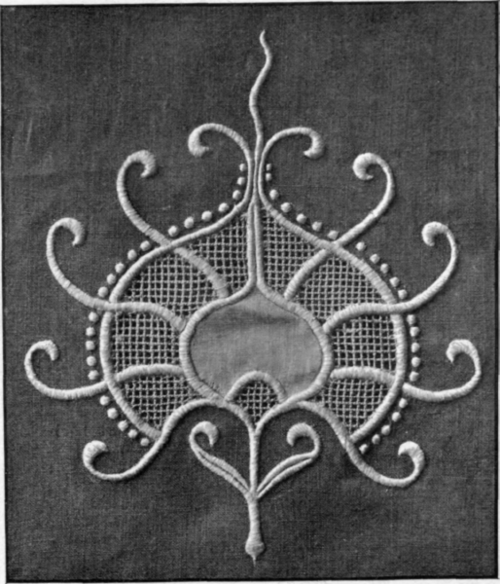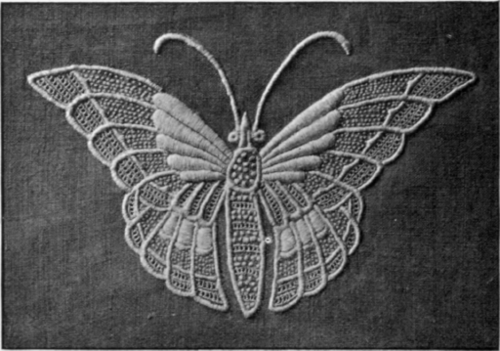Drawn Work
Description
This section is from the book "A Book About Embroidery", by Lewis F. Day. Also available from Amazon: Art In Needlework: A Book About Embroidery..
Drawn Work
By piercing a number of holes very close one to sparring another, and binding them together at the edges, a OR SPOKE kind of open-work is produced which, as may be seen in the vase shape in Illustration 91 (White Work On Linen), need not by any means follow the square lines of the weaving, as drawn work must do. The lines, for example, across the butterfly's body in Illustration 96 (White Work With Seeding And Sparring) would of necessity have been straight if they had been
"drawn," and the open pattern on the wings could not possibly have followed their outline as it does in this "sparring" or "spoke" stitch as they call it.
What comes of drawn work, also largely used in white embroidery, is shown in Illustration 95 (White Embroidery With Applique And Drawn Work), where the square lattice pattern is the natural result of working on the threads of the material. A diaper which followed the radiating lines of the design could not possibly have been executed in drawn work. The drawing of the threads - they are not cut - does not, if judiciously done, appreciably weaken the linen. There is no suggestion of weakness, for example, in the instance given, and such open-work is an excellent foil to the satin stitch and applique with which it is constantly associated.
This enumeration of the stitches employed in County Down and Donegal, and the illustration of the practical uses to which they may be put, is only by way of showing the kinds of work which have answered the purpose of white embroidery, and will stand the wear and washing it has ordinarily to undergo. It is probable, too, that women working for their living have discovered for themselves the shortest, simplest, and in so far the best, way of doing what they set out to do. But they have by no means exhausted the possibilities of workmanship in white - there is ample evidence in old work (page 45) to the contrary. Any stitch used in coloured work will serve, provided only that it will give the texture necessary to relieve the pattern from the ground, and that it is firm and substantial enough for its purpose. No artist or amateur will think of limiting herself to the devices current in manufacture ; but to know them is to be the better prepared to make use of the suggestions everywhere to be found in needlework generally, no matter what its colour may be. Our illustrations are enough to show this. The artist in white will in the end work out her own system. It is hardly necessary to insist that there is room in white work for the most delicate and delightful art - none the less delightful that it is modest. It is inherently that.

95. White Embroidery With Applique And Drawn Work

Continue to:


